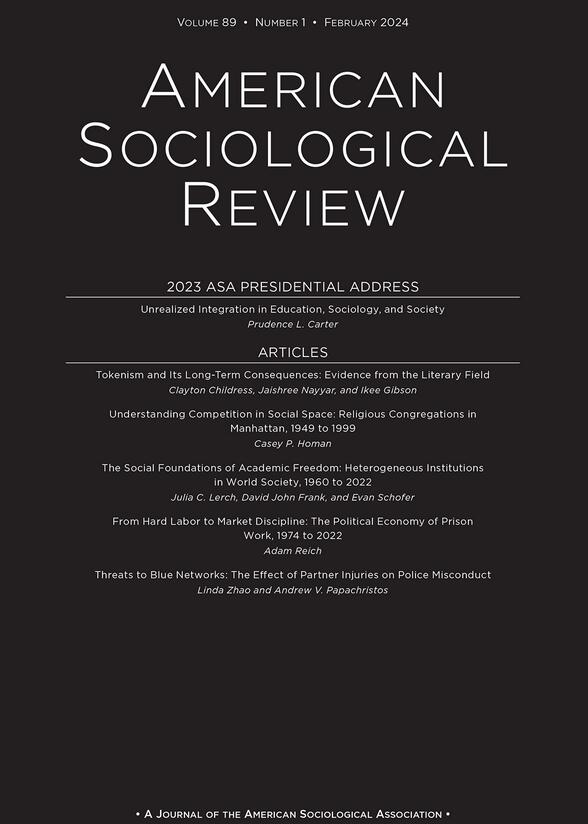婚姻论文非制度化评价的实验检验
IF 6.2
1区 社会学
Q1 SOCIOLOGY
引用次数: 2
摘要
本文试图通过实验来评估婚姻在美国是非制度化的这一论点。为此,我们绘制了关于异性伴侣是否应该结婚的规范的特征图,并从四个维度确定了规范的强弱程度:极性,规范是规定性的、禁止性的、两极性的(既有规定性的,也有禁止性的),还是不存在;条件性,规范是否在任何情况下都适用;强度,个体对规范的认同程度;以及共识,即个人共享规范的程度。对不成比例的美国成年人分层随机样本(N=1823)进行的析因调查实验结果表明,结婚规范很弱:它在很大程度上是双相的、有条件的,强度从低到中等,对规范以及划分规范的环境存在分歧。虽然男性和女性以及黑人和白人受访者的结婚规范不同,但群体内部的分歧(或缺乏共识)在不同群体之间是相当的。我们发现社会经济地位(教育、收入和职业阶层)之间没有显著差异。总的来说,我们的研究结果支持了婚姻论文非制度化的关键主张。本文章由计算机程序翻译,如有差异,请以英文原文为准。
Assessing the Deinstitutionalization of Marriage Thesis: An Experimental Test
This article seeks to experimentally evaluate the thesis that marriage is deinstitutionalized in the United States. To do so, we map the character of the norm about whether different-sex couples ought to marry, and we identify the extent to which the norm is strong or weak along four dimensions: polarity, whether the norm is prescriptive, proscriptive, bipolar (both prescriptive and proscriptive), or nonexistent; conditionality, whether the norm holds under all circumstances; intensity, the degree to which individuals subscribe to the norm; and consensus, the extent to which individuals share the norm. Results of a factorial survey experiment administered to a disproportionate stratified random sample of U.S. adults (N = 1,823) indicate that the norm to marry is weak: it is largely bipolar, conditional, and of low-to-moderate intensity, with disagreement over the norm as well as the circumstances demarcating the norm. While the norm to marry is different for men and women and for Black and White respondents, the amount of disagreement (or lack of consensus) within groups is comparable between groups. We find no significant differences across socioeconomic status (education, income, and occupational class). Overall, our findings support key claims of the deinstitutionalization of marriage thesis.
求助全文
通过发布文献求助,成功后即可免费获取论文全文。
去求助
来源期刊

American Sociological Review
SOCIOLOGY-
CiteScore
13.30
自引率
3.30%
发文量
35
期刊介绍:
The American Sociological Association (ASA) is a non-profit membership association established in 1905. Its mission is to advance sociology as a scientific discipline and profession that serves the public good. ASA is comprised of approximately 12,000 members including faculty members, researchers, practitioners, and students in the field of sociology. Roughly 20% of the members work in government, business, or non-profit organizations.
One of ASA's primary endeavors is the publication and dissemination of important sociological research. To this end, they founded the American Sociological Review (ASR) in 1936. ASR is the flagship journal of the association and publishes original works that are of general interest and contribute to the advancement of sociology. The journal seeks to publish new theoretical developments, research results that enhance our understanding of fundamental social processes, and significant methodological innovations. ASR welcomes submissions from all areas of sociology, placing an emphasis on exceptional quality.
Aside from ASR, ASA also publishes 14 professional journals and magazines. Additionally, they organize an annual meeting that attracts over 6,000 participants. ASA's membership consists of scholars, professionals, and students dedicated to the study and application of sociology in various domains of society.
 求助内容:
求助内容: 应助结果提醒方式:
应助结果提醒方式:


